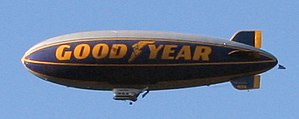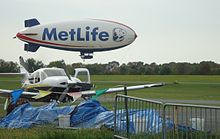Blimp

Ablimp(/blɪmp/), ornon-rigid airship,is anairship(dirigible)[1]without an internal structural framework or a keel. Unlikesemi-rigidandrigid airships(e.g.Zeppelins), blimps rely on the pressure of thelifting gas(usuallyhelium,rather thanhydrogen) inside the envelope and the strength of the envelope itself to maintain their shape. Blimps are known for their use in advertising, surveillance, and as observation platforms due to their maneuverability and steady flight capabilities.[2]
Principle
[edit]
Since blimps keep their shape with internal overpressure, typically the only solid parts are the passenger car (gondola) and thetail fins.A non-rigid airship that uses heated air instead of a light gas (such as helium) as a lifting medium is called ahot-air airship(sometimes there arebattensnear the bow, which assist with higher forces there from a mooring attachment or from the greater aerodynamic pressures there).
Volume changes of the lifting gas due to temperature changes or to changes of altitude are compensated for by pumping air into internalballonets(air bags) to maintain the overpressure. Without sufficient overpressure, the blimp loses its ability to be steered and is slowed due to increased drag and distortion. The propellerair streamcan be used to inflate the ballonets and so the hull. In some models, such as theSkyship 600,differential ballonet inflation can provide a measure ofpitch trimcontrol.
The engines driving the propellers are usually directly attached to the gondola, and in some models are partly steerable.
Blimps are the most commonly built airships because they are relatively easy to build and easy to transport once deflated. However, because of their unstable hull, their size is limited. A blimp with too long a hullmay kink in the middlewhen the overpressure is insufficient or when maneuvered too fast (this has also happened with semi-rigid airships with weak keels). This led to the development ofsemi-rigidsandrigid airships.
Modern blimps are launched somewhat heavier than air (overweight), in contrast to historic blimps. The missing lift is provided by lifting the nose and using engine power, or by angling the engine thrust. Some types also use steerable propellers orducted fans.Operating in a state heavier than air avoids the need to dumpballastat lift-off and also avoids the need to lose costly helium lifting gas on landing (most of theZeppelinsachieved lift with very inexpensive hydrogen, which could be vented without concern to decrease altitude).
Etymology
[edit]
The origin of the word "blimp" has been the subject of some confusion. Lennart Ege notes two possible derivations:[3]
Colloquially non-rigid airships always were referred to as "Blimps". Over the years several explanations have been advanced about the origin of this word. The most common is that in the military vernacular the Type B was referred to as "limp bag", which was simply abbreviated to "blimp".[4]An alternative explanation is that on 5 December 1915, Commander A. D. Cunningham,R.N.,of theCapel-Le-Ferne Air Ship Station,flicked the envelope of the airship SS.12 with his fingers during an inspection, which produced a sound that he mimicked and pronounced as "blimp"; and that the word then caught on as the nickname for all small non-rigid airships.[4][5]
A 1943 etymology, published inThe New York Times,supports a British origin during the First World War when the British were experimenting with lighter-than-air craft. The initial non-rigid aircraft was called the A-limp; and a second version called the B-limp was deemed more satisfactory.[6]
Yet a third derivation is given by Barnes and James inShortsAircraft since 1900:
In February 1915 the need for anti-submarine patrol airships became urgent, and theSubmarine Scouttype was quickly improvised by hanging an obsoleteB.E.2cfuselagefrom a spareWillowsenvelope; this was done by theR.N.A.S.atKingsnorth,and on seeing the result for the first time,Horace Short,already noted for his very apt and original vocabulary, named it "Blimp", adding, "What else would you call it?"[7]
Dr. A. D. Topping researched the origins of the word and concluded that the British had never had a "Type B, limp" designation, and that Cunningham's coinage appeared to be the correct explanation.[8]
TheOxford English Dictionarynotes its use in print in 1916: "Visited the Blimps... this afternoon atCapel".In 1918, theIllustrated London Newssaid that it was "an onomatopœic name invented by that genius for apposite nomenclature, the late Horace Short".[9]
Use
[edit]
TheB-class blimpswere patrol airships operated by theUnited States Navyduring and shortly afterWorld War I.The Navy learned a great deal from theDN-1fiasco. The result was the very successful B-type airships.Dr. Jerome Hunsakerwas asked to develop a theory of airship design. This was followed by then-LieutenantJohn H. Towers,USN,returning from Europe having inspected British designs, and theU.S. Navysubsequently sought bids for 16 blimps from American manufacturers. On 4 February 1917 the Secretary of the Navy directed that 16 nonrigid airships of Class B be procured. UltimatelyGoodyearbuilt 9 envelopes,Goodrichbuilt five andCurtissbuilt the gondolas for all of those 14 ships. Connecticut Aircraft contracted withU.S. Rubberfor its two envelopes and withPigeon Fraserfor its gondolas. The Curtiss-built gondolas were modifiedJN-4fuselages and were powered byOX-5 engines.The Connecticut Aircraft blimps were powered byHall-Scott engines.
In 1930, a former German airship officer, Captain Anton Heinen, working in the US for the US Navy on its dirigible fleet, attempted to design and build a four-place blimp called the "family air yacht" for private fliers which the inventor claimed would be priced below $10,000 and easier to fly than a fixed-wing aircraft if placed in production. It was unsuccessful.[10][11]
In 2021,Reader's Digestsaid that "consensus is that there are about 25 blimps still in existence and only about half of them are still in use for advertising purposes".[12]The Airsign Airship Group is the owner and operator of 8 of these active ships, including the Hood Blimp, DirecTV blimp, and the MetLife blimp.[13]
Surveillance blimp
[edit]
This blimp is a type ofairborne early warning and controlaircraft, typically as the active part of a system which includes a mooring platform, communications and information processing. Example systems include the U.S.JLENSand IsraeliAeronautics Defense Skystar 300.[14][15]
Surveillance blimps known asaerostatshave been used extensively in the Middle East by theUnited States military,theUnited Arab EmiratesandKuwait.[16]
Examples of non-rigid airships
[edit]Manufacturers in many countries have built blimps in many designs.[17]Some examples include:
- ADB-3-X01,the largest lightship ever manufactured byAirship do Brasil,the only blimp manufacturing company inLatin America
- AVIC AS700 Airship
- Astra-Torres airship,non-rigid airships manufactured bySociété Astraand used inWorld War Iby France and UK
- British Army airship Beta
- Coastal class airship,C* class airshipUK coastal blimps used in WW I
- SS,SSP,SST,SSZandNS class airships,convoy escort blimps used by the UK in WW I
- G class blimpandL class blimp,US training blimps built by Goodyear duringWorld War II
- K class blimpandM class blimp,US anti-submarine blimps operated during World War II
- MantainerArdath,an Australian blimp, in use during the mid-1970s
- N class blimp(the "Nan ship" ), used for anti-submarine and as a radar early-warning platform during the 1950s
- Goodyear Blimps,a fleet of blimps operated for advertising purposes and as atelevision cameraplatform
- Skyship 600,a private blimp used by advertising companies
- P-791,an experimental aerostatic/aerodynamichybrid airshipdeveloped byLockheed-Martincorporation
- SVAM CA-80,an airship manufactured by the Shanghai Vantage Airship Manufacture Co inChina
- TC-3and TC-7, two US Army Corps non-rigid blimps used forparasite fightertrials during 1923–24
- WDL 2,airship for aerial advertising manufactured and used by WDL Group, Germany
- Willows airships
-
DIRECTV blimpAirship, Model A-170LS Video Lightsign
See also
[edit]- Airship hangar
- List of current airships in the United States
- Mooring mast
- Solar aircraft
- Thermal airship,a type of blimp using hot air for lift
Notes
[edit]- ^"blimp".Lexico.Oxford University Press. Archived fromthe originalon 29 July 2020.Retrieved24 November2020.
- ^Smith, Jessica (9 January 2024)."Difference Between Blimp Or Zeppelin?".Retrieved5 February2024.
- ^Ege, Lennart (1973).Balloons and Airships, and Dirigibles 1783–1973.Translated by Munson, Kenneth. London: Blandford.ISBN978-0-7137-0568-3.
- ^abMeager, George (1970).My Airship Flights 1915–1930.London: William Kimber and Co. p. 32.ISBN978-0-7183-0331-0.
- ^Goddard, Victor (1968). "Per Ardua—Peradventure: A Contemporary Review of Innovations during the First Fifty Years of the Royal Air Force".The Aeronautical Journal.72(694).Royal Aeronautical Society:857.doi:10.1017/S0001924000085237.ISSN0001-9240.S2CID115595814.
- ^"Origin of 'Blimp' Explained".The New York Times.3 January 1943.
- ^Barnes & James 1989,p. 13.
- ^van Beverhoudt, Arnold E. (2013).These Are the Voyages: A History of the Ships, Aircraft, and Spacecraft NamedEnterprise.Lulu.com. p. 119.ISBN978-0-557-17825-4.
- ^"blimp".Oxford English Dictionary(2nd ed.). Oxford University Press. 1989.
- ^"Aeronautics: Air Yacht".Time.Vol. 16, no. 18. 3 November 1930.
- ^"Dirigible Air Yacht Has Automobile Cabin".Popular Mechanics.Vol. 54, no. 6. December 1930. p. 967.
- ^Cutolo, Morgan (3 April 2021)."Here's Why You Don't See Blimps Anymore".
- ^Broughton, David (23 June 2014)."Flying high: How sponsors, networks and fans make the business of blimps soar".Sports Business Journal.Retrieved1 November2015.
- ^"Military blimp escapes, causes power outages before landing in Pennsylvania".Stars and Stripes.Retrieved30 October2015.
- ^"Military Blimp Gets Loose, Cuts Power Lines".AVweb.28 October 2015.Retrieved30 October2015.
- ^Pocock, Chris (12 November 2011)."Aerostats Rise Through the Ranks in Surveillance Service".ainonline.com.Retrieved20 May2022.
- ^"FAQs – Business of blimps".Goodyear Tire and Rubber Company.Archived fromthe originalon 2 March 2010.Retrieved13 December2009.
- ^"The MetLife Blimp".MetLife.2009. Archived fromthe originalon 19 December 2009.Retrieved13 December2009.
References
[edit]- Barnes, C. H.; James, D. N. (1989).Shorts Aircraft since 1900.London: Putnam.ISBN0-85177-819-4.
External links
[edit]- Popular Mechanics,June 1943,"Gas Bags Go On Patrol"detailed article on antisubmarine blimps during World War II
- "How The First Sea-Air Rescue Was Made", October 1944, Popular Sciencefirst air-to-sea rescue without aircraft landing first




![An A-60+, the MetLife Snoopy Two[18]](https://upload.wikimedia.org/wikipedia/commons/thumb/a/ae/Metlife_snoopy_two_blimp.jpg/120px-Metlife_snoopy_two_blimp.jpg)